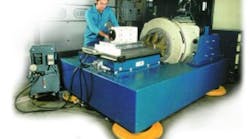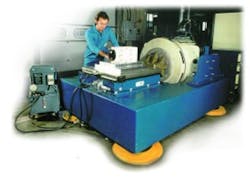Environmental testing answers questions like, “How do you know the design will withstand -30°F or being driven the length of the Trans Alaskan Highway or both?”. In its simplest form, environmental testing simulates the normal operating stresses to which a product will be subjected. Tests of this type are used for reliability-demonstration or product-acceptance testing.
Of course, having proven that the product successfully meets its environmental specification, the question left unanswered is, “How long will it continue to do so?”. In many ways, answering this question is a much greater challenge than proving that the equipment operated correctly for a limited period of time on one day.
Assuming that the specification accurately reflects the actual environmental stresses the product will experience in use, environmental stress screening (ESS) attempts to precipitate latent defects. For example, burn-in, a simple form of ESS, accelerates certain types of failure modes that give rise to the familiar bathtub-shaped failure rate vs time curve. If the infant mortality portion of the curve can be eliminated before the product is shipped, the reliability of the units entering the field will be greater.
Many electronic devices respond to burn-in in this way, but there has been a shift of emphasis as manufacturing methods have changed. As early as 1994, the increased reliability of surface-mount components had altered the distribution of failure modes. At that time, manufacturing engineers at Heraeus Industrietechnik in Germany commented that only 20% of product defects were due to component failure, the remaining 80% being related to assembly errors.1
Different forms of environmental stress testing (EST) identify critical areas of a design so that product reliability can be improved and the production test effort better targeted. Highly accelerated life testing (HALT) is a form of EST used to determine which components or subassemblies are most susceptible to applied stresses. HALT uses levels of vibration and rates of temperature cycling much greater than would be seen in normal operation. The intention is to destroy the product, but gradually, so that relatively simple failure modes and their causes can be understood and corrected. Ultimately, hard limits will be reached that require too much design effort to overcome.
Having found which areas fail, an ESS program can be established to concentrate on these aspects of the product. ESS can be accelerated, but a balance must be struck between precipitating latent faults and actually causing new faults. Highly accelerated stress screening (HASS) is intended to accomplish even more fault elimination than has been shown to result from a good ESS program and in much less time. Because HASS is a production test applied to all products, its severity must be shown to have little effect on the life of products ultimately delivered to the customer.
During a product’s design phase, environmental extremes also are applied. Tests must be performed to confirm that the specification has been met, but also to establish suitable margins beyond the specification. The differences between the test requirements of production HASS and those of design engineering are related to flexibility.
As a result, different types of environmental test products have evolved to serve different test needs. For example, compressed-air-driven actuators provide the very high vibration levels in several axes that are characteristic of HALT and HASS test chambers. By separately modulating the airflow to each actuator and using a damped, segmented table, broadband random vibration can be produced.
On the other hand, an electrodynamic shaker can be controlled to replicate the actual vibration experienced by a vehicle in a road test. Close control of user-selected, different-frequency sinusoids can be accomplished in conjunction with levels of random vibration.
But one shaker only exercises one axis of vibration at a time. Also, it can be expensive to provide a rigid fixture suitable for vibrating several units to increase throughput. The relatively large platform in a HALT/HASS chamber accommodates multiple or larger products more readily. Mechanical reaction shakers also provide a large mounting area, but are limited to relatively low frequencies and one or two axes of vibration.
Forces for Change
Against this background, there are new features that promise to improve test-equipment performance and flexibility as well as new types of environmental test products. Jan Debille, product manager for durability test at LMS International in Belgium, identified changes in three areas of technology that he thinks will contribute to faster product development at low cost while preserving quality standards.
“The availability of damage assessment and simulation software has enabled design engineers to take a critical look at the true damage potential their products should be designed against,” he said. “This tool can be used to develop realistic design and test specifications, avoiding costly over-design and testing.
“Integration has resulted in test-lab benefits. At the transducer level, the IEEE 1451 transducer electronic data sheet (TEDS) eliminates the possibility of making many types of mistakes because the transducer has integrated electronics that contain important information such as calibration data,” he continued.
“The third improvement,” Mr. Debille concluded, “is in software technology. Important concepts include open database connectivity (ODBC) support for transducer information management, fully configurable user interfaces, automated plotting, live interactive menus, and browser-like database access.”
Agreeing with Mr. Debille was John Van Baren, president of Vibration Research, “New [environmental test] products need to be user friendly and make test reporting easy. This has driven a flurry of activity in the computer-controlling and software industry supplying the user interfaces to these testing products.
“I see a bigger interest in environmental testing in the commercial segment,” Mr. Van Baren continued. “Manufacturers are being pushed to make products that work out of the box and continue to work for a reasonable amount of time. Consequently, testing must be done not only to see if the product passes a test, but also to find all the weak points. Then decide if and how to fix them.”
Speeding It Up
As many environmental test-equipment suppliers have found, customers are constantly looking for improved equipment that tests faster, increases reliability, and is easier to use. Automation helps achieve these goals and is becoming more common in semiconductor testing applications, for example.
According to Michael Schoknecht, a sales engineer at Micro Control, “As the devices being tested become more expensive, it is more important that automation protects against human error in handling. Automation also speeds up the loading and unloading process. In a hot environment, automation is not affected by the extreme temperatures. Devices can be removed as soon as the test is done instead of waiting for them to cool.”
LMS’s Mr. Debille also considers automation as a way to eliminate errors and increase speed, but added a cautionary note: “By fully automating the entire process, the people currently involved in testing could lose their sense of reality, and the expertise necessary to work in this complex field would dry up.”
Similar concerns were echoed by Micro Control’s Mr. Schoknecht. “Automation eliminates human intuition about what is happening during the environmental test. If something goes wrong, or the test starts improperly, automation may not catch the problem,” he explained.
Several companies EE contacted stated that the initial high cost of automation was its largest negative aspect. Mr. Schoknecht summed it up, “Environmental test usually is not fully appreciated, so its budget tends to be small, and automation generally is one of the first things to go.”
Jeffrey Marshall, vice president of sales and marketing at M/RAD, concurred that the cost of automation was a problem, but added that the increase in test speed it afforded should give a quick payback. He was more concerned about the present short-time-horizon in the industry.
“The current trend is deferment of or dramatic cuts in capital equipment purchasing. Furthermore,” he explained, “the pendulum seems to be swinging in the direction of companies choosing to have test laboratories perform environmental testing rather than purchasing equipment themselves.”
Reducing the Cost of Test
For customers continuing to undertake their own testing, reducing the cost of test takes several forms. In the semiconductor industry, Mr. Schoknecht of Micro Control sees “electrical testing being done during the environmental stress or burn-in process. This allows the devices within the chamber to be tested for two variables: environment and function.
“Customers are offloading their long-time electrical test into their long-time environmental test,” he elaborated. “This helps minimize the overall test time and improves the time to market. Since long-time tests are necessary, why not combine them? This is especially true when burning in semiconductor devices.” Expensive floor space required by multiple machines also is minimized by performing more tests with one machine.
Test costs can be reduced by making the tests easier and, as a result, quicker to perform. An example is the addition of a remote-control capability to a vibration controller. Dr. Sri Welaratna, president of Data Physics, described the application.
“In the automotive industry, [particularly for squeak and rattle testing], a separate command center is used to manually adjust test parameters while the shaker is running. An operator standing near the shaker and away from the control room uses the command center. The command center runs a subset of the vibration control system interface and provides essential manual controls. In a sine sweep test, the controls might include pause, set frequency, or reverse sweep direction.”
PC-based vibration controllers also are driving down the cost of test. As Dr. Welaratna explained, “Data Physics had anticipated the current trend toward PC-based shaker control systems that are much lower in cost than the UNIX-based systems of just a few years ago. Since that time, the trend continues toward PC controllers at lower cost.”
Reference
- Rasp, R., and Gavin, F., “Tunnel Systems Emerge as New ESS Strategy,” EE-Evaluation Engineering, July 1994, pp. 34, 36.
Return to EE Home Page
Published by EE-Evaluation Engineering
All contents © 2000 Nelson Publishing Inc.
No reprint, distribution, or reuse in any medium is permitted
without the express written consent of the publisher.
April 2000

